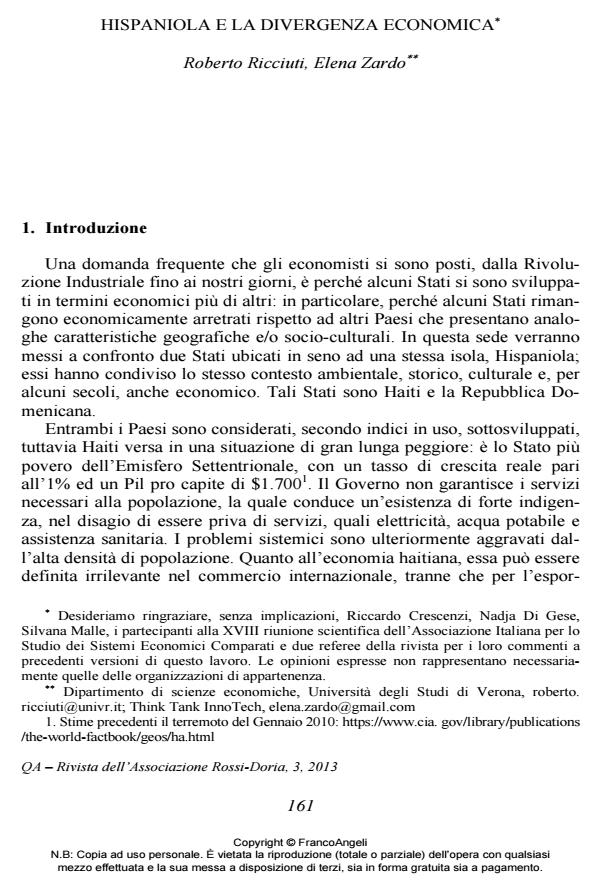Hispaniola and its Economic Divergence
Journal title QA Rivista dell’Associazione Rossi-Doria
Author/s Roberto Ricciuti, Elena Zardo
Publishing Year 2013 Issue 2013/3 Language Italian
Pages 24 P. 161-184 File size 552 KB
DOI 10.3280/QU2013-003005
DOI is like a bar code for intellectual property: to have more infomation
click here
Below, you can see the article first page
If you want to buy this article in PDF format, you can do it, following the instructions to buy download credits

FrancoAngeli is member of Publishers International Linking Association, Inc (PILA), a not-for-profit association which run the CrossRef service enabling links to and from online scholarly content.
Haiti and the Dominican Republic, which are respectively on the left and right side of the island of Hispaniola, represent an interesting case of economic divergence: whereas in colonial times Haiti was richer than the current Dominican Republic, it is now one of the poorest countries in the Northern hemisphere, while the Dominican Republic is a developing country with a relatively good income per capita.We analyze possible institutional causes of this divergence, focusing on the effects of the different percentage of European colonizers on the island in the 17th century, the allocation of land in the 19th century, and the role of the US. EconLit Classification: O120, N900, P480
Keywords: Institutions, Development, Economic policy
- Acemoglu D., Johnson S., Robinson J.A. (2001), «The Colonial Origins of Comparative Development: An Empirical Investigation», American Economic Review, 91, pp. 1369-1401.
- Acemoglu D., Johnson S., Robinson J.A. (2003), «An African Success Story: Botswana », in Rodrik D. (ed.), In Search of Prosperity: Analytic Narratives on Economic Growth, Princeton University Press, pp. 80-122.
- Andrews G.R. (2007), Afro-Latinoamerica 1800-2000, Iberoamericana – Vervuert Arthur B.W. (1994), Increasing Returns and Path Dependence in the Economy, University of Michigan Press., Ann Arbor, Michigan.
- Bethell L. (1985), Cambridge History of Latin America, vol. III, Cambridge University Press, Cambridge.
- Bihlmeyer K., Tuechle H. (1996), Storia della Chiesa, vol. III, L’Epoca delle Riforme, Morcelliana, Brescia, pp. 183-184.
- Bulmer-Thomas V. (2001), «The Wider Caribbean in the 20th Century: A Long-Run Development Perspective», Integration and Trade, 5, pp. 5-56.
- Cook S., Borah W. (1980), Ensayos sobre historia de la poblacion: Mexico y el Caribe, Siglo XXI, Mexico.
- David P.A. (1985), «Clio and the Economics of QWERTY», American Economic Review, 75, pp. 332-337.
- Diamond J. (1997), Guns, Germs and Steel. The Fates of Human Societies, W.W. Norton, New York.
- Diamond J. (2005), Collasso. Come le società scelgono di morire o vivere, Einaudi, Torino.
- Diamond J., Robinson J.A. (2010), Natural Experiments of History, Harvard University Press, Cambridge.
- Dubois L. (2004), Avengers of the New World. The Story of the Haitian Revolution, Belknap Harvard University Press, Cambridge.
- Fick C. (1990), The Making of Haiti: The Saint-Domingue Revolution from Below, University of Tennessee Press, Knoxville.
- Geggus D. (1982), Slavery, War and Revolution, Oxford University Press, Oxford Gutierrez Escudero A. (1985), Poblation y economia en Santo Domingo (1700-1746), Diputacion Provincial, Siviglia.
- Himmerich y Valencia R. (1991), The Encomenderos of New Spain, 1521-1555, University of Texas Press, Austin.
- Hoetink H. (1982), The Dominican People: Notes for a Historical Sociology, Johns Hopkins Press, Baltimore.
- Imf (2001), «The Dominican Republic: Stabilization, Reform and Growth», Occasional Paper, 206, International Monetary Fund, Washington, Dc.
- Janvier L.J. (1883), La République D’Haïti Et Ses Visiteurs (1840-1882): Réponse À M. Victor Cochinat (De La Petite Presse) Et À Quelques Autres Écrivains, Marpon et Flammarion, Paris.
- Jaramillo L., Sancak C. (2007), «Growth in the Dominican Republic and Haiti: Why Has the Grass Been Greener on One Side of Hispaniola», IMF Working Paper No 07/63, International Monetary Fund, Washington, Dc.
- Lundahl M. (2001), «Poorest in the Caribbean: Haiti in the Twentieth Century», Integration and Trade, 5, pp. 177-200.
- Livi Bacci M. (2003), «Return To Hispaniola: Reassessing a Demographic Catastrophe », Hispanic American Historical Review, 83, pp. 3-52.
- Maddison A. (2007), Contours of the World Economy: 1-2030 AD, Oxford University Press, Oxford.
- Metzler J. (1991), America Pontificia. Primi speculi evangelizationis 1493-1592, 2 tomi, Città del Vaticano, Roma. Nicholls D. (1985), Haiti in the Caribbean Context, MacMillan, London.
- Pichardo Viñals H. (1984), Las ordenanzas antiguas para los indios: las leyes de Burgos, 1512, Editorial de Ciencias Sociales, La Habana.
- Romano R. (1992), Opposte congiunture, Marsilio, Venezia.
- Wiarda H. (1966), Dominican Republic: A Nation in Transition, Pall Mall Press, London.
- World Bank (2006), Dominican Republic: Country Economic Memorandum: The Foundations of Growth and Competitiveness, Latin America and the Caribbean Region, Washington, Dc.
Roberto Ricciuti, Elena Zardo, Hispaniola e la divergenza economica in "QA Rivista dell’Associazione Rossi-Doria" 3/2013, pp 161-184, DOI: 10.3280/QU2013-003005